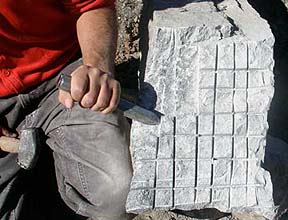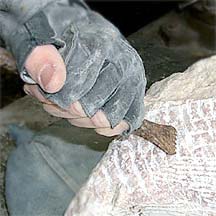Sculpture Carving Process

The first chisel you use is the point chisel.
Hold the chisel with your thumb on the outside over the knuckle. It feels awkward at first, but prevents accidentally striking your thumb with the hammer. Hold the point loosely. Look at the tip when chiseling. Let the weight of the hammer do the work.
Start carving by cutting parallel rows about an inch apart in the stone, creating ridges and grooves. Hold the chisel at an angle that just bites into the stone (75 degree), but not so steeply that it will bury the tool.
Chiseling directly into the stone will bruise the stone causing “white marks” to ¼” into the stone. Now go back over the same area with a crosshatch pattern of cuts to knock off the ridges of the first cuts. Place the point so it catches under the ridge and the force pops the chip off.
Using this technique, begin defining the geometric planes of the large forms. Work away from the highpoint of your sculpture. Be careful not to work too close to the edges if you want to keep them. Carve parallel to the edge rather than perpendicular.
Defining the Forms:

Once the large forms have been established with the point chisel, begin refining them with a tooth chisel. Hold this chisel tighter with your thumb braced against the tool. Use a 45-degree angle. A higher angle only bruises the stone; a lower angle just skips over the surface. As with the point, try to catch the tool under a ridge of stone to pop it off.
Hold the tooth chisel close to the tip. Try to keep all the teeth in contact with the stone at one time as not to break a tooth off the chisel. Always overlap your chisel marks slightly. When chiseling, try to rest your arm on the stone to keep steady.
The point chisel has left a rough texture of grooves and ridges, which can be smoothed down with the tooth chisel. The tooth chisel closely follows the contours of the forms. Continue to carve in two directions creating a crosshatch.
If your sculpture is small you may use less of the point and more of the tooth chisel at the beginning.
A flat chisel is now used on flat or convex forms to remove the texture left by the tooth chisel. Use the curved edge of the rondel to clean out concave shapes.
During this cleaning up stage, you will discover if you have bruised the stone and need to do extra work to remove the white marks
When you want to keep stone in one area and remove it in another, you can use the edge of a flat chisel to score a line. You can use the tooth chisel to remove stone below the line, keeping the stone on the other side of the line. If you use the point to score the line, stone will break off on both sides.